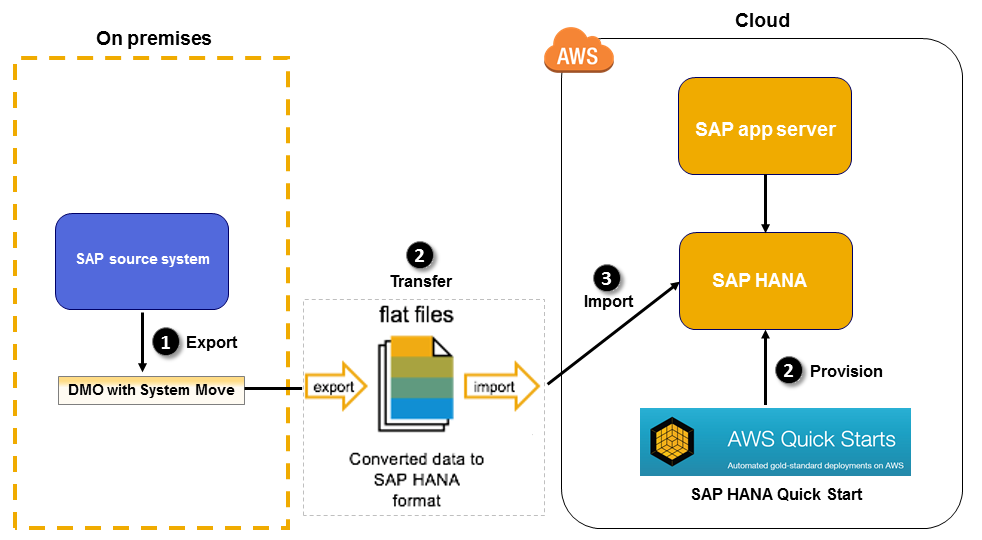AWS for SAP
FAST SAP Migrations to AWS with the SAP Rapid Migration Test Program
Somckit Khemmanivanh is an SAP Solutions Architect at Amazon Web Services (AWS).
If you have an on-premises SAP application running on a non-HANA (anyDB) database, you can now use the SAP Rapid Migration Test program with Amazon Web Services (AWS) to migrate to an SAP HANA (or ASE) version of your application on AWS. The SAP Rapid Migration Test program (also known as FAST, which stands for Fast AWS and SAP Transformation) provides a set of processes, procedures, and tools that SAP developed in collaboration with AWS to help customers running SAP applications (SAP ECC and SAP Business Warehouse) on anyDB to migrate to SAP HANA or SAP ASE on AWS.
You can use FAST to migrate your SAP system to AWS and upgrade it to SAP HANA in record time, using your own in-house resources, remote consulting, or a consulting partner. AWS was chosen as the development and launch partner for this initiative due to the flexibility and scale of the AWS platform. SAP and AWS partnered on the pilot phase of the program and found that migrations can be completed in as little as 48 hours and for as little as $1,000 in infrastructure costs.
As part of the FAST program, SAP has enhanced the database migration option (DMO) of their Software Update Manager (SUM) (see SAP Note 2377305) to accelerate the migration testing of SAP applications. (SAP notes require SAP login credentials.) This enhancement in SUM 1.0 SP 20, called DMO with System Move, enables you to migrate your SAP system from your on-premises site to AWS by using a special export and import process. You can use the AWS Quick Start for SAP HANA to rapidly provision SAP HANA instances and build your SAP applications on AWS. You can additionally use AWS services such as Amazon S3, Amazon EFS (over AWS Direct Connect), AWS Storage Gateway file interface, and AWS Snowball to transfer your SAP files to AWS.
The SUM DMO tool can convert data from anyDB to SAP HANA, with OS migrations, release/enhancement pack upgrades, and Unicode conversions occurring at the same time. Results are written to flat files, which are transferred to a rapidly provisioned SAP HANA system on the AWS platform. The second phase of DMO with System Move imports the flat files and builds the migrated SAP application with the extracted data, code, and configuration. Here’s a conceptual flow of the major steps involved:
In step 1, you use the SUM DMO tool to export the SAP source to a storage location in the form of flat files. Depending on your use case and requirements, this location could be an existing AWS service you’ve already configured (such as Amazon EFS or a file gateway) or a local file system on the source server. Step 2 involves transferring the exported flat files to AWS. (Note: Depending on your storage location technology, you might not have to explicitly transfer files to AWS. For example, if you used Amazon EFS or a file gateway with AWS Storage Gateway, your files would be transferred to AWS automatically.) While the files are being transferred, you can use the SAP HANA Quick Start to provision the SAP HANA system and optionally install SAP HANA. Typical provisioning times for SAP HANA range from 30 minutes to less than one hour for larger SAP HANA scale-out systems. Lastly, step 3 involves the actual import of the flat files into the newly provisioned SAP HANA system.
With the SAP Rapid Migration Test program, SAP customers who don’t have SAP HANA licenses can get a limited test license from their SAP account team. SAP customers can use the DMO with System Move process themselves or partner with an AWS Partner Network (APN) SAP partner.
Here’s what Daniel Schneiss, SVP, SAP HANA Platform had to say about FAST on the SAP website:
“Another example of our collaboration is FAST, which stands for Fast AWS and SAP Transformation and is a programmatic and tooling collaboration around the extension of the SAP Database Migration Option (SAP DMO) for system moves combined with AWS Quick Start for SAP.
If you have an on-premise SAP application running on a non-SAP-HANA (anyDB) database, you can now use the SAP Rapid Migration Test program with Amazon Web Services (AWS) to migrate to an SAP HANA or SAP ASE version of your application on AWS. FAST provides a set of processes, procedures, and tools that SAP developed in collaboration with AWS to help customers running SAP applications (SAP ECC and SAP Business Warehouse) on anyDB to migrate to SAP HANA or SAP ASE on AWS.
Building on that, we are currently developing a joint strategy for customers to offer solutions that help migrate large workloads onto SAP HANA on AWS Cloud. By combining AWS and SAP migration technologies, we will offer an even more complete migration offering for custom non-SAP applications by both AWS and SAP, and add to the overall customer value proposition. The achievements to date mark just the start of SAP and AWS’ trusted and successful partnership, so stay tuned for more milestones to come!”
Watch a video to see what Paul Young, Global VP, SAP Customer Strategy, SAP Database & Data Management, had to say about FAST at the AWS re:Invent 2017 conference.
We’d like to hear about your experiences using AWS for SAP applications. If you have any questions or suggestions, feel free to contact us.
Thank you!
– Somckit
